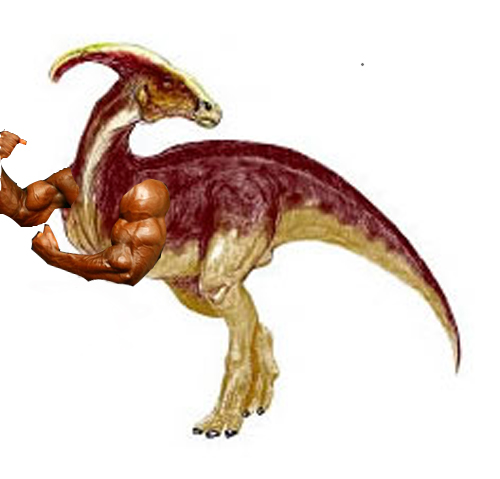Today's post was going to be just about Siats Meekerorum, a new species of theropod found in Utah, but then I decided that the good old tyrannosaurs had to be represented too, so this post will be about both Siats and the tyrannosaurid Lythronax Argestes.
Hailing from the mid cretaceous, Siats Meekerorum is a species of neovenatorid. The neovenatorids were a family closesly related to the allosaurids, which were prominent during the Jurassic period. These neovenatorids continued the precedent of allosaur dominance through about half of the cretaceous, before the better-known-today tyrannosaurids came onto the scene. The name of this new species essentially means "demon-beast of Meeker." Siats is the name of a man-eating monster from the Ute tribe of Utah's mythology. It's a bit like Grendel.
I feel like the story would've turned out differently if Grendel was a dinosaur.
Living at the same time, and even the same place, was a tyrannosaur far larger than its small dog-sized brethren scuttling under the feet of the enormous Siats. Lythronax Argestes, the "Southern King of Gore" was the first large Tyrannosaurid.
It's good to be king.
At 24 feet long and 2.5 tons, Lythronax was smaller than its allosaur antagonist, but that by no means means it was weaker. Lythronax had strong leg muscles made for running, compared to Siats with its much larger bulkier body (hence the large discrepancy in weight, but little difference in length). Lythronax also had the blocky head and incredibly strong neck and jaw muscles typical of the Tyrannosaurs. Along with this Lythronax had a larger brain case proportionally than Siats, meaning it had more acute senses and was more intelligent. In a fight, it seems to me that the Lythronax had a pretty good chance of winning. Although Siats would be a worthy adversary, the superior agility and proportionally stronger jaw muscles of Lythronax would probably allow it to win. The comparison is of a Hyperion to a satyr. Today's post is just full of literary references.
Seeing as the two lived at the same time and place, this seems that to suggest that rather than the huge neovenatorids being an unstoppable evolutionary wall the tyrannosaurs had to wait out, they were more of an obstacle to be overcome. This would also help to solve the mystery of the final extinction of the neovenatorid family, since the Tyrannosaurs could have out competed them to extinction. Then again I suppose I am rather biased towards the Tyrannosaurs. Tyrannosaurs are the best. They've always been there for you. Always looking out for you. When you need a dinosaur to tear something apart, you look to your best friend the Tyrannosaurus. He cares about you. No one looks to an allosaur to do anything right, that would totally be betraying the king, and that would be treason. No uppity new allosaur discovery is gonna displace the Tyrannosaurs. Long live Lythronax, LONG LIVE THE KING.
Seeing as the two lived at the same time and place, this seems that to suggest that rather than the huge neovenatorids being an unstoppable evolutionary wall the tyrannosaurs had to wait out, they were more of an obstacle to be overcome. This would also help to solve the mystery of the final extinction of the neovenatorid family, since the Tyrannosaurs could have out competed them to extinction. Then again I suppose I am rather biased towards the Tyrannosaurs. Tyrannosaurs are the best. They've always been there for you. Always looking out for you. When you need a dinosaur to tear something apart, you look to your best friend the Tyrannosaurus. He cares about you. No one looks to an allosaur to do anything right, that would totally be betraying the king, and that would be treason. No uppity new allosaur discovery is gonna displace the Tyrannosaurs. Long live Lythronax, LONG LIVE THE KING.
Ahem. Anyway. I get emotional when it comes to Tyrannosaurs. They're just the most beautiful things. I think that's it for today's post. The next one will be about something else. Maybe a review of that new Walking With Dinosaurs movie. I loved the old documentary series, but I have a bad feeling about this new one...
-Athos
Switek, Brian. "Newfound Giant Dinosaur Ruled Before T. Rex." National Geographic. National Geographic Society, 22 Nov. 2013. Web. 10 Dec. 2013.
Vergano, Dan. "Newfound "King of Gore" Dinosaur Ruled Before T. Rex." National Geographic Society. National Geographic Society N.p., 6 Nov. 2013. Web. 10 Dec. 2013.
"Allosaurus Fragilis." Fossilworks: Gateway to the Paleobiology Database. N.p., n.d. Web. 10 Dec. 2013.
Switek, Brian. "Newfound Giant Dinosaur Ruled Before T. Rex." National Geographic. National Geographic Society, 22 Nov. 2013. Web. 10 Dec. 2013.
Vergano, Dan. "Newfound "King of Gore" Dinosaur Ruled Before T. Rex." National Geographic Society. National Geographic Society N.p., 6 Nov. 2013. Web. 10 Dec. 2013.
"Allosaurus Fragilis." Fossilworks: Gateway to the Paleobiology Database. N.p., n.d. Web. 10 Dec. 2013.














.bmp)











